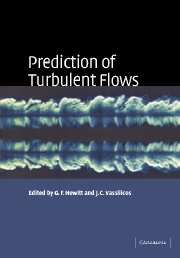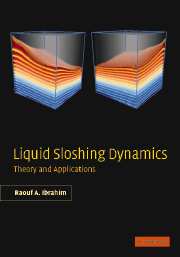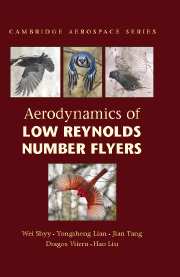3653 results in ebooks in fluid mechanics

Prediction of Turbulent Flows
-
- Published online:
- 12 August 2009
- Print publication:
- 08 June 2005

Liquid Sloshing Dynamics
- Theory and Applications
-
- Published online:
- 11 August 2009
- Print publication:
- 19 May 2005
List of contributors
-
- Book:
- Partial Differential Equations and Fluid Mechanics
- Published online:
- 07 September 2011
- Print publication:
- 16 July 2009, pp x-xii
-
- Chapter
- Export citation
5 - Singularity formation and separation phenomena in boundary layer theory
-
-
- Book:
- Partial Differential Equations and Fluid Mechanics
- Published online:
- 07 September 2011
- Print publication:
- 16 July 2009, pp 81-120
-
- Chapter
- Export citation
7 - Anisotropic Navier–Stokes equations in a bounded cylindrical domain
-
-
- Book:
- Partial Differential Equations and Fluid Mechanics
- Published online:
- 07 September 2011
- Print publication:
- 16 July 2009, pp 146-184
-
- Chapter
- Export citation
6 - Partial regularity results for solutions of the Navier–Stokes system
-
-
- Book:
- Partial Differential Equations and Fluid Mechanics
- Published online:
- 07 September 2011
- Print publication:
- 16 July 2009, pp 121-145
-
- Chapter
- Export citation
9 - Contour dynamics for the surface quasi-geostrophic equation
-
-
- Book:
- Partial Differential Equations and Fluid Mechanics
- Published online:
- 07 September 2011
- Print publication:
- 16 July 2009, pp 207-227
-
- Chapter
- Export citation
4 - Some controllability results in fluid mechanics
-
-
- Book:
- Partial Differential Equations and Fluid Mechanics
- Published online:
- 07 September 2011
- Print publication:
- 16 July 2009, pp 64-80
-
- Chapter
- Export citation
Contents
-
- Book:
- Partial Differential Equations and Fluid Mechanics
- Published online:
- 07 September 2011
- Print publication:
- 16 July 2009, pp vii-viii
-
- Chapter
- Export citation
1 - Shear flows and their attractors
-
-
- Book:
- Partial Differential Equations and Fluid Mechanics
- Published online:
- 07 September 2011
- Print publication:
- 16 July 2009, pp 1-25
-
- Chapter
- Export citation
10 - Theory and applications of statistical solutions of the Navier–Stokes equations
-
-
- Book:
- Partial Differential Equations and Fluid Mechanics
- Published online:
- 07 September 2011
- Print publication:
- 16 July 2009, pp 228-257
-
- Chapter
- Export citation
Frontmatter
-
- Book:
- Partial Differential Equations and Fluid Mechanics
- Published online:
- 07 September 2011
- Print publication:
- 16 July 2009, pp i-vi
-
- Chapter
- Export citation
2 - Mathematical results concerning unsteady flows of chemically reacting incompressible fluids
-
-
- Book:
- Partial Differential Equations and Fluid Mechanics
- Published online:
- 07 September 2011
- Print publication:
- 16 July 2009, pp 26-53
-
- Chapter
- Export citation
Preface
-
-
- Book:
- Partial Differential Equations and Fluid Mechanics
- Published online:
- 07 September 2011
- Print publication:
- 16 July 2009, pp ix-ix
-
- Chapter
- Export citation
3 - The uniqueness of Lagrangian trajectories in Navier–Stokes flows
-
-
- Book:
- Partial Differential Equations and Fluid Mechanics
- Published online:
- 07 September 2011
- Print publication:
- 16 July 2009, pp 54-63
-
- Chapter
- Export citation
8 - The regularity problem for the three-dimensional Navier–Stokes equations
-
-
- Book:
- Partial Differential Equations and Fluid Mechanics
- Published online:
- 07 September 2011
- Print publication:
- 16 July 2009, pp 185-206
-
- Chapter
- Export citation

Aerodynamics of Low Reynolds Number Flyers
-
- Published online:
- 05 July 2009
- Print publication:
- 22 October 2007
3 - Viscoelastic P, SI, and SII Waves
-
- Book:
- Viscoelastic Waves in Layered Media
- Published online:
- 29 October 2009
- Print publication:
- 14 May 2009, pp 32-97
-
- Chapter
- Export citation
Preface
-
- Book:
- Viscoelastic Waves in Layered Media
- Published online:
- 29 October 2009
- Print publication:
- 14 May 2009, pp xi-xvi
-
- Chapter
- Export citation
5 - General P, SI, and SII Waves Incident on a Viscoelastic Boundary
-
- Book:
- Viscoelastic Waves in Layered Media
- Published online:
- 29 October 2009
- Print publication:
- 14 May 2009, pp 107-142
-
- Chapter
- Export citation
